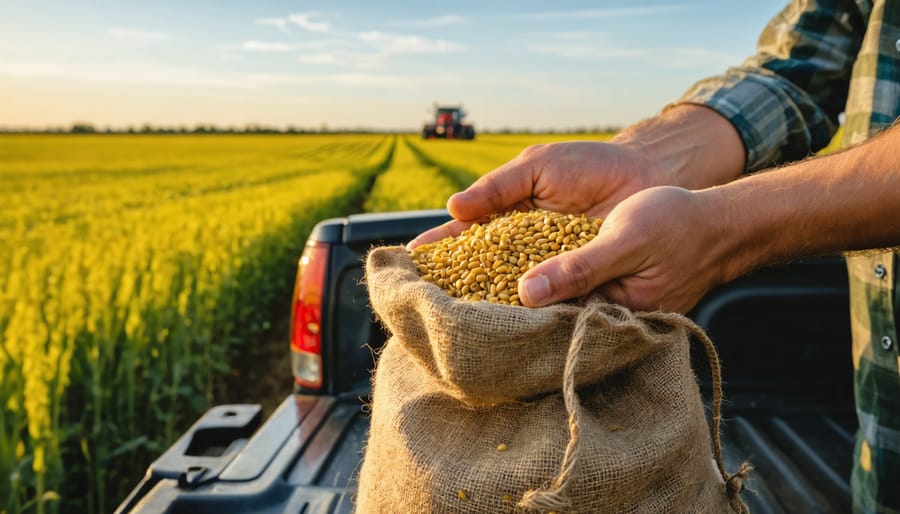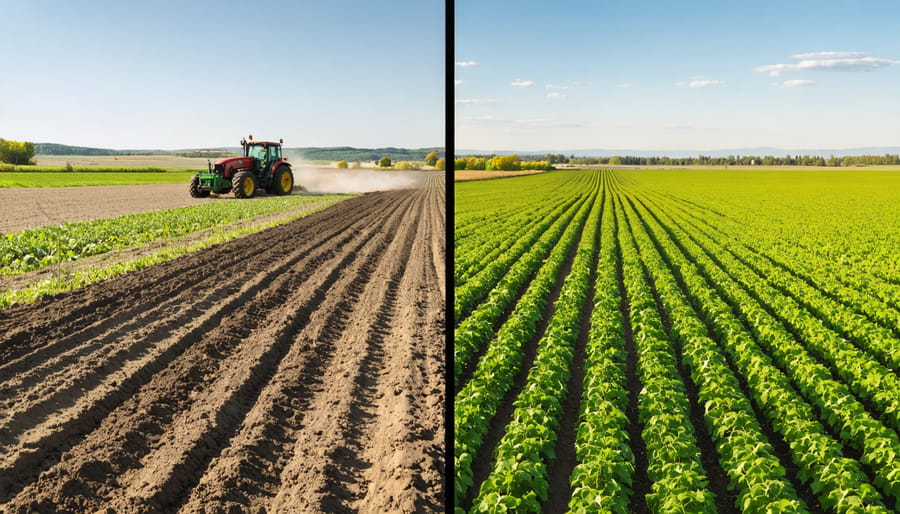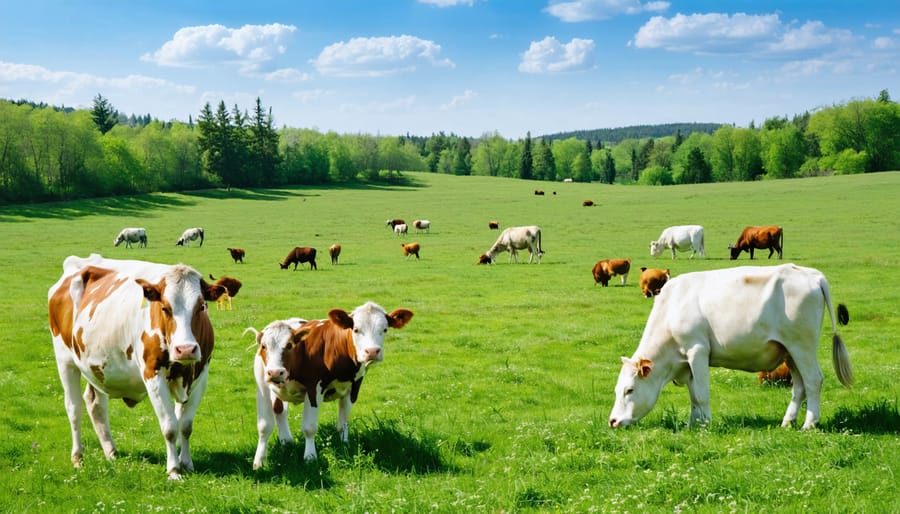The European Union and United States represent the world’s largest bilateral trade relationship, exchanging over €1.1 trillion in goods and services annually – a partnership that directly impacts Canadian agricultural exports. For Alberta farmers, particularly those shipping organic grains and pulses, understanding the complex interplay between these two economic giants offers critical market opportunities. Recent harmonization of organic certification standards between the EU and US has created streamlined export pathways, reducing compliance costs by up to 25% for Canadian producers who meet dual-market requirements. As trade tensions fluctuate and sustainability demands intensify, Alberta’s agricultural sector stands uniquely positioned to leverage these transatlantic relationships, with organic exports to both markets growing at an average rate of 14% annually over the past five years. This evolving trade dynamic presents both challenges and opportunities for Canadian farmers seeking to expand their international market presence while maintaining compliance with evolving regulatory frameworks.

The Current Trade Landscape
Key Trade Agreements in Place
The EU-US Organic Equivalency Arrangement, established in 2012, stands as a cornerstone agreement facilitating organic trade between these major markets. Under this arrangement, products certified to either EU or US organic standards can be sold as organic in both regions, provided they meet specific requirements. This has significantly streamlined the certification process for Canadian exporters working with both markets.
Several organic organizations in Canada work closely with producers to navigate these requirements, ensuring compliance with both EU and US standards. The agreement covers most organic products, with some exceptions for antibiotics in livestock production and aquaculture products.
For Alberta farmers, this means organic crops and livestock products certified to Canadian organic standards (which align with US requirements) can generally access both markets without additional certification. However, producers should maintain detailed documentation of their organic practices and work with accredited certifying bodies to ensure continued compliance with evolving standards.
The arrangement also includes provisions for ongoing cooperation in areas such as pest control methods, animal welfare standards, and soil management practices, helping maintain the integrity of organic certification across borders.
Market Access Challenges
Canadian organic farmers face several key challenges when accessing international markets, particularly in EU and US trade. Documentation requirements often differ between regions, creating additional administrative burden. For example, Alberta grain farmers must maintain separate certification records for each market, significantly increasing paperwork and compliance costs.
Varying organic standards between jurisdictions pose another significant hurdle. While Canada maintains equivalency agreements with both the EU and US, certain products may still require additional certification steps. Local organic dairy producers frequently report challenges with differing regulations around animal welfare standards and permitted inputs.
Transportation logistics also present considerable challenges, especially for perishable goods. Meeting strict temperature control requirements while maintaining organic integrity during long-distance shipping can substantially impact costs. Many Alberta producers have found success by partnering with specialized organic logistics providers who understand these unique requirements.
Market access costs can be prohibitive for smaller operations. Certification fees, inspection costs, and maintaining multiple compliance systems often require significant investment. However, producer cooperatives have emerged as an effective solution, allowing farmers to share resources and expertise while accessing international markets collectively.
Policy Harmonization Benefits
Streamlined Certification Process
The harmonization of EU and US organic standards has created a more efficient organic certification process that benefits Canadian farmers looking to expand their market reach. Under the unified system, producers who meet Canadian organic standards can more easily access both European and American markets without requiring separate certifications for each region.
For Alberta farmers, this streamlined approach means reduced paperwork and lower certification costs. Instead of navigating multiple regulatory frameworks, producers can now follow a single set of guidelines that satisfy requirements across these major markets. The unified standards particularly benefit grain and pulse farmers, who can now certify their crops once and sell to buyers in both the EU and US.
Local success stories highlight the practical advantages of this harmonized system. Take the Schmidt family farm near Lethbridge, which reduced their certification timeline by six weeks and saved approximately $3,000 in administrative costs during their first year under the unified standards. Their experience demonstrates how simplified procedures can directly impact a farm’s bottom line.
Key benefits of the streamlined process include:
– Single inspection visits covering multiple market requirements
– Standardized documentation accepted across regions
– Reduced certification fees
– Faster processing times for export permits
– Simplified record-keeping systems
For new organic producers, this harmonization provides a clear pathway to international markets. Working with local certification bodies, farmers can develop compliance strategies that align with both EU and US requirements from the start, creating more efficient and sustainable export operations.

Cost Reduction Opportunities
The harmonization of EU and US trade regulations presents significant cost-saving opportunities for Canadian organic farmers, particularly through streamlined certification cost reduction programs. When regulations align between these major markets, farmers can avoid duplicate certification processes, reducing administrative overhead and inspection fees by up to 40%.
For Alberta farmers currently exporting to both markets, the unified standards mean maintaining just one comprehensive certification rather than separate documentation for each region. This consolidation typically saves operations between $2,000 and $5,000 annually in direct certification costs. Additionally, harmonized regulations reduce the need for separate storage facilities and handling procedures, leading to operational savings of approximately 15-20%.
The financial benefits extend beyond direct certification costs. Streamlined documentation requirements decrease staff training time and administrative hours by roughly 25%. Farmers report spending an average of 10 fewer hours per month on paperwork when operating under harmonized standards. Laboratory testing costs also decrease significantly, as one set of analyses can satisfy both markets’ requirements.
Storage and inventory management become more efficient under unified regulations. Farmers can maintain single production lines and storage areas instead of segregating products based on different market requirements. This optimization typically results in a 10-15% reduction in storage and handling costs.
For smaller operations, these savings can make the difference between profitable international market access and being limited to domestic sales. The harmonization particularly benefits those growing specialty crops like organic grains and pulses, where market diversification is crucial for sustainable business growth.
Practical Implementation Steps

Documentation Requirements
Maintaining detailed records is crucial for farmers engaging in EU-US trade, with both regions requiring comprehensive documentation to ensure compliance. For Alberta farmers, this means implementing a robust record-keeping system that tracks every step of the production process.
Essential documents include detailed field histories, crop rotation plans, and input records showing all materials used in production. Keep seed purchase receipts, organic certificates, and processing records readily available. Digital record-keeping systems have become increasingly popular, offering efficient storage and easy access during inspections.
Storage and handling documentation must clearly demonstrate separation between organic and conventional products. Maintain transport records showing clean-out procedures and verification that no contamination occurred during shipping.
For export documentation, you’ll need:
– Transaction certificates
– Organic product certificates
– Phytosanitary certificates
– Bills of lading
– Import/export declarations
All records must be maintained for a minimum of five years, though some certifiers recommend longer retention periods. Consider implementing a monthly audit system to ensure all documentation stays current and compliant with both EU and US requirements.
Many Alberta farmers have found success using cloud-based management systems that automatically organize and backup documentation. These systems can generate reports quickly during inspections and help track document expiration dates, reducing the risk of compliance issues.
Remember to regularly update your record-keeping procedures as regulations evolve. Your local organic certifier can provide guidance on specific documentation requirements for your operation.
Certification Adjustments
Aligning with harmonized standards between EU and US markets requires careful attention to certification adjustments. For Alberta farmers looking to expand their market reach, understanding these requirements is crucial. The first step involves reviewing current USDA organic certification requirements and identifying any gaps in compliance.
Begin by documenting your current organic practices and comparing them against both EU and US standards. Key areas of focus include soil management, pest control methods, and record-keeping systems. Many Alberta farmers find that their existing Canadian organic practices already align with many international requirements, making the adjustment process more manageable.
Consider implementing a dual-tracking system for documentation, which allows you to maintain records that satisfy both EU and US requirements simultaneously. This might include detailed input logs, harvest records, and storage protocols that meet the strictest standards of both regions.
Work with local organic certification bodies that have experience in international trade certification. These organizations can provide valuable guidance on specific adjustments needed for your operation. Many Alberta farmers have successfully navigated this process by participating in certification workshops and connecting with mentors who have already achieved dual certification.
Remember to plan for annual reviews and updates to your certification documentation, as requirements may evolve. Maintaining open communication with your certifier will help ensure smooth transitions when standards change.
Resource Management
As Canadian farmers adapt to meet international trade requirements, understanding and implementing unified farming practices becomes crucial. Alberta farmers have shown remarkable adaptability in aligning their operations with both EU and US standards, particularly in resource management approaches.
Local success stories, like the Morrison Family Farm in Lacombe County, demonstrate how strategic planning can streamline compliance with both markets. By implementing integrated pest management systems and maintaining detailed documentation of water usage and soil health metrics, they’ve successfully met certification requirements for both regions without duplicating efforts.
Key adaptations include:
– Implementing comprehensive soil testing programs that satisfy both EU and US requirements
– Adopting water conservation practices that meet the strictest standards of both regions
– Maintaining detailed records of resource inputs using digital tracking systems
– Establishing buffer zones that comply with both jurisdictions’ specifications
The Alberta Organic Producers Association reports that farms implementing unified resource management practices see an average 15% reduction in certification-related costs. This efficiency comes from creating single systems that satisfy multiple requirements rather than managing separate protocols for each market.
For optimal resource management, farmers are encouraged to:
– Conduct regular soil analyses using internationally recognized testing methods
– Monitor water quality using standardized measurement tools
– Document all inputs and outputs using compatible recording systems
– Maintain clear audit trails for both EU and US inspections
These unified approaches not only ensure compliance but also promote sustainable farming practices that benefit the land for future generations.
Alberta Success Stories
Several Alberta organic farms have successfully navigated the complexities of international trade, demonstrating that local producers can thrive in the global marketplace. Take the Prairie Gold Organics in Lacombe, for instance. This family-operated farm expanded from local markets to exporting certified organic grains to EU buyers by meticulously documenting their production practices and investing in relationship-building with European distributors.
Red Deer Valley Organic Farm presents another inspiring example. They transformed their traditional grain operation into a diversified organic enterprise, now shipping specialty crops to both EU and US markets. Their success stems from early adoption of digital tracking systems and participation in international trade workshops, which helped them understand certification requirements across different jurisdictions.
Peace Country Organic Producers, a cooperative of fifteen farms in northern Alberta, pooled their resources to meet international shipping volumes while sharing compliance costs. Their collaborative approach enabled smaller farms to access markets that would have been unreachable individually. The group’s careful attention to soil management practices particularly impressed European buyers, who value sustainable farming methods.
Perhaps most notably, Sunshine Organic in Drumheller developed an innovative solution for tracking and documenting their production methods. Their straightforward system, which other Alberta farms have since adopted, simplifies the complex reporting requirements for both EU and US markets. Their experience shows that with proper planning and systems in place, even smaller operations can successfully navigate international organic trade requirements while maintaining their commitment to sustainable farming practices.
These success stories demonstrate that Alberta’s organic farmers can effectively participate in international trade while staying true to their values and maintaining profitable operations.
As we’ve explored throughout this article, the EU-US trade relationship presents both opportunities and challenges for Canadian farmers. The harmonization of organic standards between these major markets creates a ripple effect that directly impacts our agricultural practices here in Alberta. By staying informed and proactive, you can position your farm to benefit from these international developments.
Remember that successful adaptation to these trade dynamics requires a balanced approach: maintaining current organic certification standards while keeping an eye on evolving international requirements. Many Alberta farmers are already leading the way, demonstrating that compliance with both EU and US standards is not only achievable but can open doors to premium markets.
Looking ahead, consider taking these practical next steps: review your current certification documentation, connect with local organic certification bodies, and participate in regional farming networks to share experiences and best practices. The Alberta Organic Producers Association and similar organizations offer valuable resources and support for navigating these changes.
By focusing on sustainable practices and maintaining high-quality standards, Canadian farmers can continue to thrive in an increasingly interconnected global market while contributing to our province’s proud agricultural heritage.











